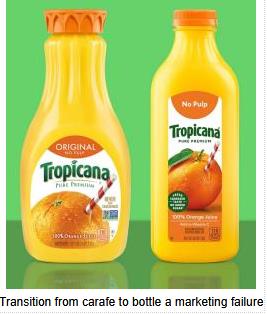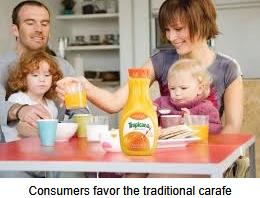 Tropicana recently replaced the traditional 51-ounce Tropicana Pure Premium Orange Juice Carafe to a 46-ounce square-sided bottle. Sales fell to 8.3 percent in July after the introduction, followed by 11 percent in August and 19 percent by October according to data released by market research company Circana. The principal response by consumers was “shrinkflation” based on the six-ounce reduction in volume, notwithstanding a corresponding decrease in price. Consumers are obviously disenchanted with the replacement of a familiar container with an easy-to-hold neck and a familiar closure.
Tropicana recently replaced the traditional 51-ounce Tropicana Pure Premium Orange Juice Carafe to a 46-ounce square-sided bottle. Sales fell to 8.3 percent in July after the introduction, followed by 11 percent in August and 19 percent by October according to data released by market research company Circana. The principal response by consumers was “shrinkflation” based on the six-ounce reduction in volume, notwithstanding a corresponding decrease in price. Consumers are obviously disenchanted with the replacement of a familiar container with an easy-to-hold neck and a familiar closure.
In theory, the square-sided bottle is easier to store and transport and takes up less space in a refrigerator. Unfortunately label space is limited and consumers searching for the iconic carafe are passing over the new container with unfamiliar labeling. Tropicana relinquished brand identity by adopting a bottle similar to its competitors in the mistaken notion that convenience through the supply chain would be acceptable to consumers.
Post-transition consumer evaluation confirmed a preference for the carafe over the new format based on “committed preference” quantifying the degree of willingness to buy a new product over their conventional brand. Why Tropicana was so myopic in failing to judge consumer acceptance before launching the new pack is difficult to comprehend. The company has a history of  marketing missteps. Under the previous ownership of PepsiCo the traditional gable top carton was redesigned in 2009 removing the iconic drinking straw and orange motif in favor of a glass of orange juice. Following rollout of the new packaging, sales fell by 20 percent resulting in restoration of the original packaging within months.
marketing missteps. Under the previous ownership of PepsiCo the traditional gable top carton was redesigned in 2009 removing the iconic drinking straw and orange motif in favor of a glass of orange juice. Following rollout of the new packaging, sales fell by 20 percent resulting in restoration of the original packaging within months.
During the mid-2000s a national brand of enriched organic and cage-free table eggs substituted a fiber carton for their longstanding PET pack for West coast stores. This was based on a correct perception that consumers favored recyclable and biodegradable material but ignored the drawing power of familiarity. Obviously this created confusion at the shelf and notwithstanding similar labeling, images, logo and text sales fell sharply. With restoration of the PET pack, volume reverted to previous levels within a short time.
If it ‘aint broke don't try and fix it!